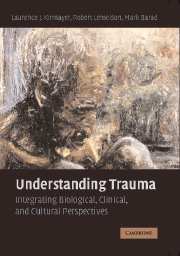Book contents
- Frontmatter
- Contents
- List of Figures
- List of Tables
- List of Contributors
- Foreword by Robert Jay Lifton
- Preface
- List of Abbreviations
- Introduction: Inscribing Trauma in Culture, Brain, and Body
- SECTION I NEUROBIOLOGICAL PERSPECTIVES ON TRAUMA
- SECTION II CLINICAL PERSPECTIVES ON TRAUMA
- 8 Cognitive Behavioral Treatments for Posttraumatic Stress Disorder
- 9 PTSD Among Traumatized Refugees
- 10 PTSD: A Disorder of Recovery?
- 11 The Developmental Impact of Childhood Trauma
- 12 Adaptation, Ecosocial Safety Signals, and the Trajectory of PTSD
- 13 Religion and Spirituality After Trauma
- 14 Posttraumatic Suffering as a Source of Transformation: A Clinical Perspective
- SECTION III CULTURAL PERSPECTIVES ON TRAUMA
- Epilogue: Trauma and the Vicissitudes of Interdisciplinary Integration
- Glossary
- Index
- References
10 - PTSD: A Disorder of Recovery?
Published online by Cambridge University Press: 27 July 2009
- Frontmatter
- Contents
- List of Figures
- List of Tables
- List of Contributors
- Foreword by Robert Jay Lifton
- Preface
- List of Abbreviations
- Introduction: Inscribing Trauma in Culture, Brain, and Body
- SECTION I NEUROBIOLOGICAL PERSPECTIVES ON TRAUMA
- SECTION II CLINICAL PERSPECTIVES ON TRAUMA
- 8 Cognitive Behavioral Treatments for Posttraumatic Stress Disorder
- 9 PTSD Among Traumatized Refugees
- 10 PTSD: A Disorder of Recovery?
- 11 The Developmental Impact of Childhood Trauma
- 12 Adaptation, Ecosocial Safety Signals, and the Trajectory of PTSD
- 13 Religion and Spirituality After Trauma
- 14 Posttraumatic Suffering as a Source of Transformation: A Clinical Perspective
- SECTION III CULTURAL PERSPECTIVES ON TRAUMA
- Epilogue: Trauma and the Vicissitudes of Interdisciplinary Integration
- Glossary
- Index
- References
Summary
INTRODUCTION: A VIEW OF THE ETIOLOGY OF PTSD
Posttraumatic stress disorder is the better researched consequence of traumatic events. In its current formulation (APA, 1994) the disorder is essentially linked to the triggering event: It cannot be diagnosed in the absence of a traumatic event, and its core symptoms of reexperiencing and avoidance must refer to the traumatic event.
This perspective implies a causal link between the event and subsequent PTSD. Such a link is also intuitively appealing and frequently appears in survivors' narratives. For an external observer as well, the association between a traumatic event and PTSD appears to have some truth to it because many survivors' lives are dramatically changed by an encounter with extreme adversity or evil. Thus, from both the survivor's perspective and that of involved observers, the traumatic event is the cause of PTSD.
From a scientific point of view, however, this is only half true because many trauma survivors do not develop PTSD. A traumatic event, accordingly, is a necessary, but certainly not a sufficient cause of PTSD. If so, then what are the alternatives?
The oldest alternative to simple causation refers to individual differences in vulnerability. Historically, this mainly concerned predisposing factors, an attribution that often carried value judgments. The latter could extend from assuming a personality defect in those who broke down under stress to more understandingly relegating the causality to the wear and tear of the central nervous system by adverse living circumstances (e.g., McEwen, 2000) or birth circumstances (e.g., Meaney et al., 1991; see also Bagot et al., this volume).
- Type
- Chapter
- Information
- Understanding TraumaIntegrating Biological, Clinical, and Cultural Perspectives, pp. 207 - 223Publisher: Cambridge University PressPrint publication year: 2007
References
Accessibility information
- 15
- Cited by

